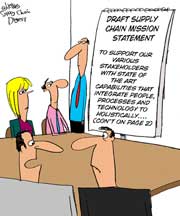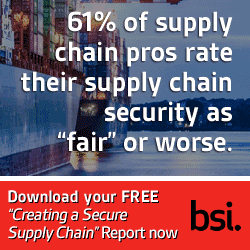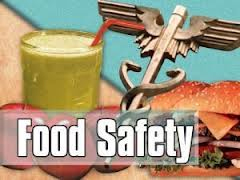 |
February 28, 2013 - Supply Chain Newsletter |
 |
| FEATURED SPONSOR: BSI |
 |
|
 |
|
|||||||||||||||||||||||||||||||||||||||||||||||||||
Understanding the Gartner Top 25 Supply Chain Rankings
|
||||||||||||||||||||||||||||||||||||||||||||||||||||
| GILMORE SAYS: |
"Is the process perfect? Certainly not. The unstated assumption is, for example, that stellar financial results equals supply chain excellence." WHAT DO YOU SAY? |
In the months after the 2012 list was released, I received calls from three separate companies asking me how they could crack the top 25, with all three feeling aggrieved they hadn't made it: a major retailer, a large consumer packaged goods company, and an industrial sort of company.
Being left off the list, it seemed, was both a matter of pride and practicality - top recruits often favor the recognized companies, they told me.
In the case of the retailer, from what I know, I thought it had an excellent case. Less sure on the other two, though no doubt they run fine supply chains.
The former AMR Research brilliantly came up with the top 25 idea in 2004. Gartner then acquired AMR in 2010. Over the last few years, the concept has been extended, so that we now have a "Next 25," a top 25 healthcare supply chains, top 25 industrial supply chains, and maybe some others I have missed.
So, let's start with the basics: how is the top 25 determined?
Gartner starts with the Fortune 500 list of top US companies by revenue and the Forbes global 2000 list that basically does the same thing on a worldwide basis. It then eliminates a lot of those companies because they do not much operate what most of us would think of as a real physical supply chain - companies in banking, insurance, software, and many more.
As an example, both IBM and Microsoft were dumped from the list in 2012 because their services related revenue rose to too high of the total versus physical product-based sales.
From that culled list, Gartner analyzes publicly available financial data, specifically looking at three metrics:
Return on assets (ROA): Net income / total assets
Inventory turns: Cost of goods sold / inventory levels
Revenue growth: Change in revenue from prior year
ROA and revenue growth use a three-year weighted average, meaning the most recent year gets the most weight and the two prior years somewhat less. Inventory turns, smartly, uses the prior year's quarterly average (reducing impact of end of year games). These three metrics together are given 50% of the total score weight.
So, at this point, you must be a decently large and public company to be considered in the analysis. The smallest company on the Fortune 500 list for 2012 had about $4.7 billion in sales. Private companies - which for example may soon include Dell as it is likely to execute a leveraged buy-out - would not have the public financial data needed for this part of formula.
Another 25% of the final rankings come from so-called "peer opinion." In 2012, this consisted of 173 apparently very influential respondents who first select a group of companies from the master list that they believe "are furthest along toward the demand-driven ideal." From those selections, they are then asked to rank those companies from first to last, from which points are assigned to companies.
So, the reference point, in theory at least, is not "the best supply chain," but rather "demand-driven leadership." Are these the same things? I would say certainly not. But I suspect the panelists in the end are probably really voting based on their perceptions of who had the best supply chains, demand-driven or not. (And yes, being "demand-driven" is certainly an attribute of supply chain excellence, all things being equal.)
So, I assume these respondents largely come from current Gartner clients, but beyond that we don't know a whole lot - and they carry a big stick in the final rankings.
The final 25% comes from votes from Gartner's own supply chain analysts. They in essence use the same tool that the peer group does.
Take the financial rankings and the votes from the peer group and the Gartner analyst group (again, 50%, 25%, and 25%, respectively), and voila, out spits the top 25 in what is certainly a pretty objective fashion.
If you are interested, you will find a link here to the top 25 for 2012, with a comparison to 2011: Gartner Releases Top 25 Supply Chain List for 2012.
Is the process perfect? Certainly not. The unstated assumption is, for example, that stellar financial results equals supply chain excellence. So, it is no surprise that Apple has been on top of the list for three straight years, given the massive success of the iPhone and iPad that has led to incredible revenue growth.
When and if that growth slows, does that mean Apple's supply chain becomes less good that year? Certainly not, but that would be the effect in this methodology.
Companies that have heavily outsourced production and distribution also have an inherent advantage. Why? Because they have chosen to shed assets, and that drives their ROA metric higher. While outsourcing can be a very smart thing for many reasons, it is not inherently a better supply chain move. This metric also inherently discriminates against asset-intensive businesses, such as chemicals and automotive. That no doubt why we see only one such company, Cummins, in the top 25 (at #23), and probably a big factor in having the separate list of the top 25 industrial supply chains.
Finally, it is biased against sectors that inherently have low inventory turns. A Home Depot or a Lowes, for example, is only going to have turns in the mid-single digits, because of their need to stock every item under the sun to meet customer needs, many of which are very slow movers. Compare that to say turns at McDonald's (number 3 on last year's list, by the way).
It penalizes a company within a given sector that strategically decides on a higher service, lower turns strategy (even though again, we can all agree that inventory efficiency is a very important attribute of supply chain excellence).
There have been some anomalies over the years. In the very first top 25 in 2004, a Korean steel maker no one ever heard of called Posco gave what admittedly was a fantastic presentation on what it was doing with its supply chain to grow its business earlier in the year at the i2 user conference. Later, Posco magically showed up at a fairly high position on the list for one year - then was never seen again.
In 2006 or so, I saw a presentation at the Georgia Tech supply chain executive forum from Mark Holifield, then newly minted VP of Supply Chain at Home Depot. He basically said Home Depot hadn't focused that much on supply chain in favor of store growth over the years, and that he was leading a major supply chain transformation there to at first just reach parity with Lowes. (That transformation has been highly successful, by the way.)
At a break, I turned to my friend Gene Tyndall and said "I have to check," and sure enough, there was Home Depot at number 17 or something on the list.
So, with all that, here in general is the advice I give: (1) understand the methodology, especially with regard to the financial data. Not much you can really do about that, but you can at least understand how it works and do some comparisons to key competitors; (2) encourage others outside your organization to participate in the peer review process; and (3) most important, if you are really serious about this, arrange "briefings" with Gartner analysts touting what you are doing in supply chain in the same way that software vendors do it. Ladle on significant helpings of demand-driven-ness. (Shoot me an email if you would like to discuss this.)
The Gartner top 25 supply chains - it has its faults, but it is the best we've got. I look forward to it every year. It certainly stirs the pot.
What are your thoughts on the Gartner top 25? Do you see any ways it could be improved? Let us know your thoughts at the Feedback button below.
![]()
| View Web/Printable Version of this Page |
|
|
|
YOUR FEEDBACK
We received a good number of excellent Feedbacks from our two First Thoughts columns by SCDigest editor Dan Gilmore on 2013 Priorities: Mapping and Modeling Your Supply Chain Part 1 and Part 2.
That includes our Feedback of the Week from network equipment maker ADTRAN's former head of supply chain and our friend Tom Dadmun, who just recently retired. Dadmun says "Mapping the entire supply chain or value chain should be undertaken not only for understanding where possible risks are, but also for training employees and benchmarking your processes."
That letter, plus other very good Feedbacks, is published below. More next week.
Feedback of the Week - On Mapping and Modeling the Supply Chain:
Mapping the entire supply chain or value chain should be undertaken not only for understanding where possible risks are, but also for training employees and benchmarking your processes. Total visibility is not known to many folks in the supply chain which can be a learning and mentoring opportunity to grow talent and expertise. In addition, the full supply or value chain starts with suppliers' suppliers but continues to customer's customer. At ADTRAN we mapped the entire value chain and posted the supply chain mapping models around a large conference room. We broke it down into 14 major functions with best in class KPI's displayed alongside our current KPI's to understand where we stood in the industry and where we needed to improve. An eye opener to many, but a "must have" to build on current success and eventually develop a BI Business Intelligent dashboard for analysis and quick response, or as you state, understanding TTR - Time To Recovery. In addition we employed the old adage "Trust but Verify." Our Transportation Director, with the mapped model in hand, then visited and tracked the flow of raw materials and finished goods from supplier to customer opening up additional opportunities to reduce time, waste and costs. Modeling the full supply chain opens up a cornucopia of opportunities that keeps on benefiting the company, the employees and the customers.
Tom Dadmun |
||
| More On Mapping and Modeling the Supply Chain: | ||
Mapping the supply chain is difficult only in that it takes effort and commitment. The commitment must come from the participants in the chain, the links, both externally and internally. While you reported the challenges of looking up the supply chain through the layers of suppliers, it may not be as much of a "protecting proprietary information" than a matter of saving face, not wanting to admit that they don't know. Looking down the chain through the layers of manufacturers, distributors and retailers can be just as difficult. The food manufacturers face this issue with product recalls. Why? Because nobody set out designing their process first - it just evolved into the process that it is. Business processes are more evolutionary in design than most managers want to or are willing to admit. Consider the old story of how the road network in New England evolved. The story goes that the network is the product of bovine engineering, where the cows on the way home from the central square decided their paths, and stuck to them. How many business processes are the product of the people that actually did the tasks? And how many processes are the product of the way the ERP system was programmed? By design? Many companies find that they are inadequately mapped for their internal processes. The mapping challenge goes beyond just the flow of material. Companies, large and small, do not have a comprehensive map of the current flows of information, decision, or money, let alone the flow of the products. Industrial engineers working the floor operations of manufacturing plants and distribution centers map out the physical flows to eliminate waste, but the back office processes are rife with waste. While there are examples of well mapped processes in large companies, these are rare examples. You will be hard pressed to find a $500 million to $1 billion revenue per year company that has a comprehensive map of the internal flows. Here is another thought, you will be just as hard pressed to find many companies with over $1 billion with defined maps of the flow of money, material and information. Mapping the process is a fundamental first step to figuring where the waste and delay hides. But not many companies value the process, they see it as a waste, mainly through a misconception of what the mapping process should do, what the outcome should be. So many don't know how to do the process quickly. And that "so many" include the consultants that claim that they know what they are doing. David Schneider |
||
About time someone said this - I have worked with many companies over the last 15 years and am amazed at how many of them only have parts of their supply chains mapped. There is so much to be learned by mapping the entire supply chain. I was working on a collaborative planning project a few years ago. We mapped the entire process and when we presented this to the two companies they vigorously disputed the process map. After doing the mapping themselves they quickly realized that over the years they had both lost visibility of how the processes had evolved. Now both companies have mapped all their supply chain, finding many other "blind-spots" that they were unaware of. Mark Barratt
|
SUPPLY CHAIN TRIVIA ANSWER
Q: The only politician to ever win CSCMP's Distinguished Service Award was former Oregon Senator Bob Packwood, in 1984. Why was he so honored?
A: For his leading role in marshaling through trucking industry deregulation legislation.
| © SupplyChainDigest™ 2003-2013. All Rights Reserved. SupplyChainDigest PO Box 714 Springboro, Ohio 45066 |
POWERED BY: XDIMENSION
|










